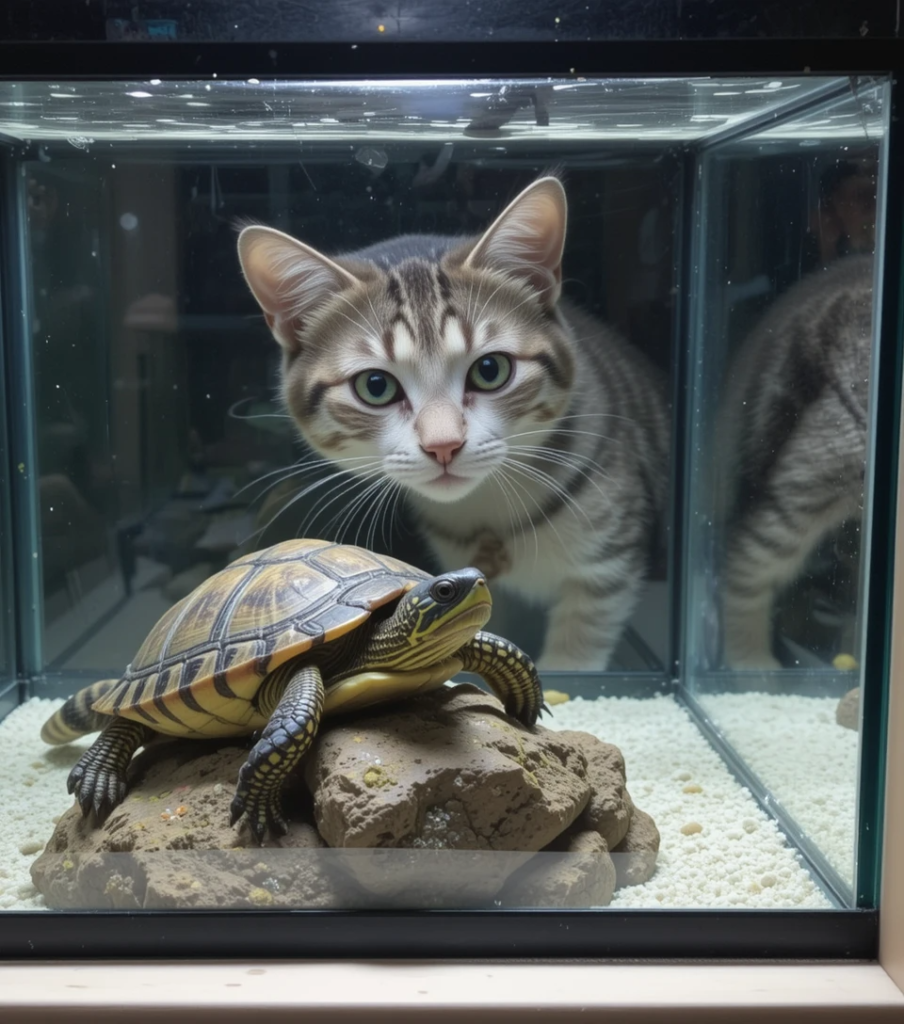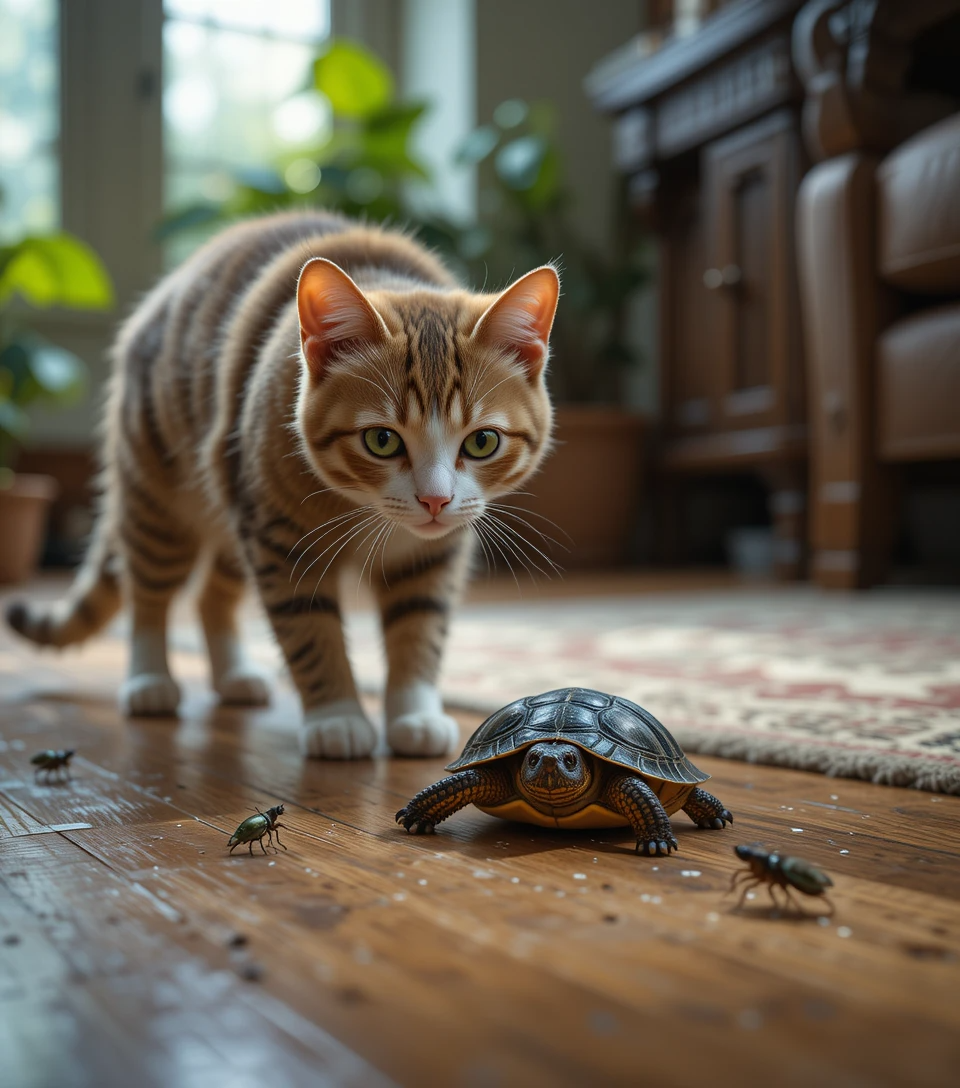It may sound strange — even alarming — but many domestic cats are naturally drawn to turtles and insects. While these behaviors can seem instinctive or harmless, they can actually pose risks to your cat, other pets, and local wildlife. Whether you’re a new cat owner or a long-time feline lover, understanding why this happens and what you can do about it is essential.
Let’s explore the reasons behind this behavior and what it means for your pet’s health and safety.
Why Domestic Cats Hunt and Eat Unusual Prey
Domestic cats, even the most pampered indoor ones, still possess strong predatory instincts. Hunting behavior is deeply rooted in their DNA, and they’re naturally triggered by small, moving creatures — including insects and slow-moving reptiles like turtles.
While outdoor cats have more opportunity to stalk live prey, indoor cats often express this drive through pouncing on bugs, attacking small toys, or, in some cases, fixating on pet turtles in shared spaces.
Are Turtles at Risk Around Domestic Cats?

Yes — small turtles, especially those kept as pets, can be vulnerable to curious or aggressive cats. Cats may paw at or even bite turtles, causing injury or significant stress.
Potential threats to turtles include:
- Scratches or bites to the shell or limbs
- Stress-induced illness from constant stalking
- Knocking over enclosures, leading to injury or escape
Safety Tips:
- Use secure tanks with lids for turtles
- Never leave cats unsupervised around small reptiles
- Watch for signs of stress in your turtle (hiding, reduced appetite)
The Truth About Cats Eating Insects
Most cat owners have seen their pet chase flies or pounce on a spider. While this is generally harmless, some insects can pose health risks.
Common insects cats eat:
- Moths, beetles, flies
- Spiders, grasshoppers, ants
- Cockroaches (can carry bacteria)
Potential dangers:
- Parasites like tapeworms
- Insecticides on sprayed bugs
- Stings or bites from bees or spiders
Note: Occasional bug munching is normal. But frequent or obsessive hunting could be a sign of boredom or dietary imbalance.
Can Eating Turtles or Bugs Harm Your Cat?
Yes — especially if your cat ingests parasites, toxins, or shell fragments.
Health concerns include:
- Digestive blockages from turtle shell pieces
- Worms or protozoa from bugs
- Pesticide poisoning if the insect has been sprayed
Warning signs:
- Vomiting or diarrhea
- Loss of appetite
- Lethargy or neurological changes
If your cat shows any of these symptoms, consult your vet immediately.
How to Protect Wildlife and Your Cat at the Same Time

Cats are responsible for the deaths of billions of small animals yearly, especially birds and reptiles. Protecting local wildlife doesn’t mean your cat has to be bored.
Balance tips:
- Keep cats indoors or supervised outside
- Use “catios” or enclosed play spaces
- Offer puzzle feeders, wand toys, and climbing trees
- Avoid letting cats roam near ponds or turtle habitats
What Veterinarians Say About This Behavior
Veterinarians generally agree: occasional bug-chasing is normal. But regular interaction with turtles or dangerous insects should be prevented.
Vet recommendations:
- Rule out dietary deficiencies
- Ensure enrichment for indoor cats
- Treat parasite infections promptly
- Create physical barriers between cats and small pets
Steps to Prevent Problematic Hunting in Cats
If your cat is obsessed with hunting turtles or insects, consider these steps:
- Provide daily play sessions using chase or feather toys
- Limit unsupervised outdoor time
- Secure your turtle’s enclosure out of paw’s reach
- Redirect attention with treat-dispensing toys or food puzzles
The goal is to mimic hunting behavior without endangering other pets or wildlife.
Should You Be Worried? A Balanced Perspective
Not all hunting is bad. In fact, it’s natural. But when it puts your cat or another animal at risk, it’s time to intervene.
Normal behavior:
- Chasing the occasional fly
- Light pawing at a secure turtle tank
Concerning behavior:
- Aggressive interaction with turtles
- Eating large quantities of bugs
- Sudden signs of illness after hunting
As with any pet concern, your best ally is a trusted vet and a thoughtful approach to your cat’s environment.
Frequently Asked Questions (FAQs)
1. Is it safe for my cat to eat bugs like spiders or flies?
Occasionally, yes — but some bugs carry toxins or parasites. Monitor for symptoms like vomiting.
2. Can a domestic cat kill or harm a turtle?
Yes. Cats can injure turtles through biting or pawing. Always supervise interactions.
3. What types of insects are dangerous for cats to eat?
Bees, spiders, and insects exposed to pesticides can be harmful or even deadly.
4. Why does my indoor cat try to hunt small pets?
It’s instinct. Cats are natural predators and may see small animals as prey.
5. Could bug consumption cause worms or parasites in cats?
Yes, especially from roaches or infected insects. Deworm your cat regularly.
6. How do I keep turtles and cats in the same home safely?
Use a secure turtle tank, keep it elevated or covered, and supervise closely.
7. Should I stop my cat from chasing insects?
If it’s safe and occasional, it’s fine. But discourage it if there’s risk involved.
8. Can eating bugs make a cat sick or throw up?
Yes — especially if the insect is toxic or has a hard exoskeleton.
9. Is this behavior a sign of dietary deficiency in cats?
Not always, but frequent insect eating can signal boredom or missing nutrients.
10. How do I train my cat to stop hunting small animals?
Redirect energy with toys, enrich their environment, and limit access to wildlife.

